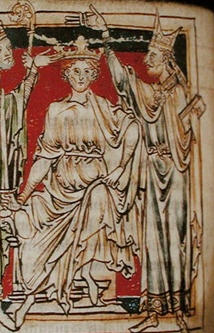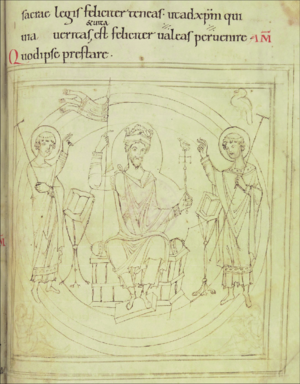Coronations of William the Conqueror and Matilda facts for kids
Quick facts for kids 
The coronation of William I, a 13th-century illustration from Flores Historiarum by Matthew Paris
|
|
| Date |
|
|---|---|
| Location | Westminster Abbey, London, England |
| Participants |
|
The coronation of William I as King of England happened at Westminster Abbey in London. This important event took place on Christmas Day, 25 December 1066. It followed the Norman Conquest of England, when William took control. This was the first coronation known for sure to have been held at Westminster Abbey. Later, in May 1068, William's wife, Matilda of Flanders, was also crowned there.
Contents
Becoming King of England
William, who was the Duke of Normandy, invaded England in September 1066. He believed he had a right to be the English king. After defeating King Harold Godwinson at the Battle of Hastings on 14 October, William marched through the south-east of England. By early December, he had forced the English leaders, known as the Witan, and their chosen king, Edgar Ætheling, to give up.
A writer named William of Poitiers said that the English nobles begged William to become king. They were used to having a king and wanted him as their leader. William's Norman army leaders then discussed if he, a duke, should accept the English throne. They quickly agreed that having William as king would help them claim lands in England later.
The Normans believed a king's rule only truly began after his coronation. So, they were in a hurry to arrange the ceremony. While waiting, Norman bishops gave their soldiers a mild punishment for killing English people. This was because it was seen as a "public war," a status that would end once William was crowned.
While plans for the coronation were being made, William went hunting. His troops started building a fortress, which later became the Tower of London. This was to control the capital city. Sadly, Norman soldiers continued to attack the English people during this time.
The Coronation Ceremony
The way coronations are done in England has changed over many years. William's coronation was the first one definitely held at Westminster Abbey. King Harold Godwinson was probably crowned there too in January 1066, but it's not fully confirmed. William chose the abbey because it was founded by King Edward the Confessor. This helped William show he was Edward's rightful successor.
The date chosen, Christmas Day, was special. It copied the tradition of emperors in other parts of Europe.
What Happened During the Service
We have a good description of the ceremony from a poem written by Guy, Bishop of Amiens. It was likely written in 1067.
The ceremony started with a procession from the Palace of Westminster to the abbey. William was led by the two most important church leaders in England: Stigand, the archbishop of Canterbury, and Ealdred, the archbishop of York. Ealdred, who was lower in rank, performed the coronation. This was because Stigand had been removed from his church duties. Geoffrey de Montbray, a Norman bishop, also helped.
Inside the church, William went to a raised platform. This was a new idea, meant to show the king was above his people. It has been used in every coronation since.
The ceremony began with Geoffrey asking the Norman nobles in French if they accepted William as king. Ealdred then repeated this in English to the Anglo-Saxon nobles. The crowd cheered loudly. However, Norman soldiers outside thought the cheering meant a riot was happening. They reacted by setting fire to nearby houses. In the confusion, some soldiers fought the fires, while others started looting.
Inside, the ceremony continued. William and the bishops knelt before the altar. Then, William was anointed with holy oil. He then took an oath. He promised to rule the people as well as the best kings before him, if they stayed loyal. This was a bit different from usual, as the oath usually came before the anointing. This change probably made the king's promise seem more sacred. The ceremony ended with William receiving the royal symbols and being seated on the throne. Finally, a church service called Mass was held.
Another writer, Orderic Vitalis, described the chaos outside. He wrote that the people inside the church were confused and rushed out. Only the bishops, clergy, and monks stayed, terrified, in front of the altar. They barely managed to finish the ceremony for the king, who was shaking badly.
The Royal Symbols
Guy of Amiens said that a Greek jeweler made a new crown for William. This crown might have looked like the crowns worn by emperors in other countries. It had strings of jewels or pearls hanging from the sides. Guy listed the twelve gems and semi-precious stones used in the crown. He said the crown "flashed on all sides with a dazzling radiance." New orbs and sceptres were also made for William by the same craftsman.
Matilda's Coronation
After his own coronation, William went to Barking Abbey. He stayed there until the Tower of London was finished, which would help him control the people of London. While there, more English nobles surrendered to him. He also held a meeting where he gave lands he had taken to his supporters.
In February, William returned to Normandy. But by December, the English people were causing trouble again. This forced William to come back to England to stop any armed groups.

After dealing with the rebellions, William sent for his wife, Matilda of Flanders. She had been acting as a ruler in Normandy and was likely pregnant. Matilda arrived in England with many ladies and maidens. She celebrated Easter with William in Winchester on 23 March 1068.
The English people were a bit confused by the title of queen. In England, the king's wife traditionally didn't have a special title. Matilda's coronation was the first for a queen of England since Edith of Wessex. It took place at Westminster Abbey on 11 May. The ceremony was similar to William's and was led by Ealdred of York. Some even said it was more magnificent than her husband's.
After the coronation, a big feast was held. During the feast, the King's Champion, Baron Marmion, challenged anyone who said William and Matilda were not the rightful king and queen. This was a Norman tradition that the English did not know about.
William's Second Coronation
From 1068 to 1070, William was very busy making sure he had full control over England. Many Anglo-Saxon people were against his rule. There was even a rebellion in Yorkshire, which led to the "Harrying of the North," where William destroyed many areas. There was also an attempted invasion by King Sweyn Estrithson of Denmark.
In early 1070, Pope Alexander II sent three church representatives, called legates, to England. They called for a church meeting in Winchester. On 4 April 1070, Easter Day, William was crowned for a second time. This happened at Winchester's Old Minster, with the Pope's representatives leading the ceremony.
There is no mention of William taking any new oaths during this second coronation. His right to rule still came from his first coronation. The purpose of this second ceremony was not to make him king again, but to show his power and his strong connection to the Church.


